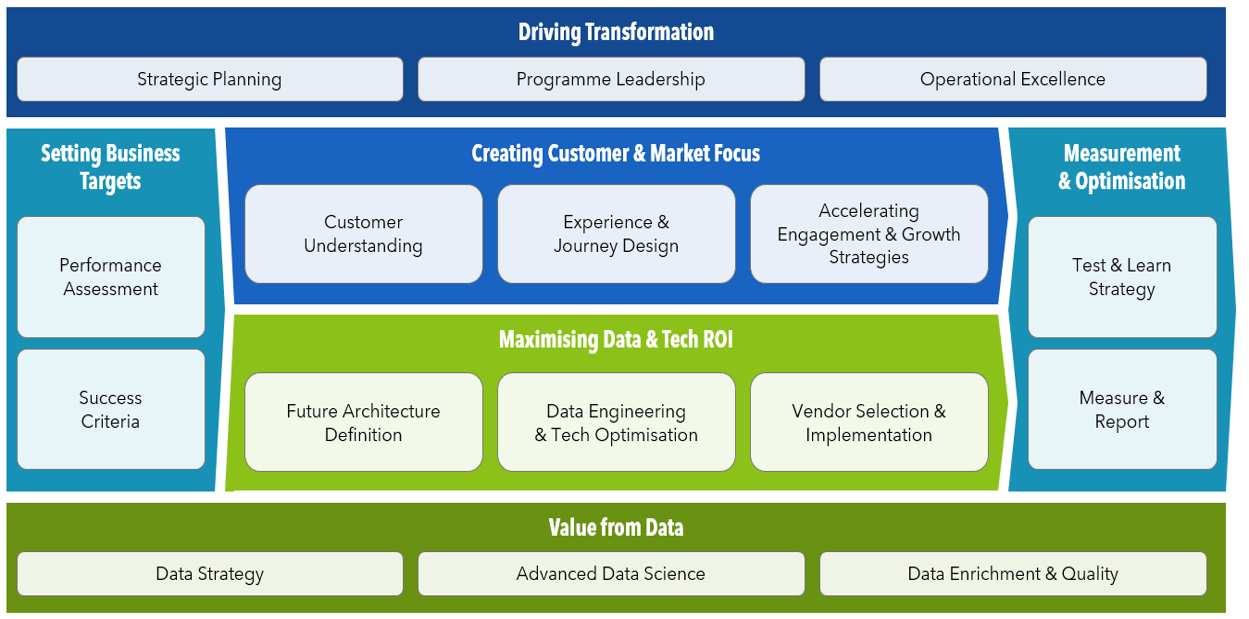Creating a transformational MarTech Stack

I had the recent pleasure of joining Matt McRoberts (Braze) and Rob Murphy (mParticle) on a panel at Braze Forge in London. We lent into a topic that is high-up the priority list for those working in experience, product, and marketing roles – “how do we create a transformational MarTech stack?”
With MarTech (technology for marketing and advertising usage) becoming a core capability for delivering enhanced customer experiences, the MarTech we have (or lack) can be a major blocker to progress. An email provider that can’t handle real-time messaging, an advertising tool that doesn’t have sight of first-party data, and insight tools that can’t analyse the customer’s journey.
I wanted to share a few takeaways from the panel that will hopefully help you in your MarTech transformation:
1. Are you truly aiming for transformation?
Recent research that Braze and CACI conducted found that whilst 86% of financial services firms believed they were delivering a great experience, only 40% of customers agreed. This disparity is at the heart of the question of whether brands know what it takes to deliver a transformed experience.
Areas to focus on:
- Audit your current communications to understand where you are now
- Segment your market and gather customer feedback to understand what your customers would consider transformational
- Design future customer journeys that express what a transformed experience looks like
2. Transformational MarTech stacks become digital nervous systems
With a promised 12x improvement in conversion rates for action-based comms vs batch comms, the ability to listen, predict and react is a critical core capability. Yet too many marketing teams are hamstrung not just by slow data integrations, but also by outdated campaigning processes requiring them to write briefs down and submit them to be processed.
The digital nervous system is constantly listening and capable of reacting immediately to inbound triggers or predictions.
Areas to focus on:
- Review your existing MarTech architecture to understand blockers, siloes and bottlenecks
- Map out your operating model, to understand what would need to change in order to deliver more real-time automated comms
3. Politics and rigidity are the enemies of transformation
Looking around the audience at Braze Forge, there were experienced marketers who wanted to be delivering better comms experiences. There was no challenge to the ideals of real-time personalised experience being superior drivers of improved short-term and long-term results.
Despite the shared ambition, I see many brands being held back by politics and rigidity. Politics meaning the control, authority, and power to make good decisions. And rigidity being the inability to act at pace.
Therefore, the ideal MarTech leader needs to demonstrate the ability to develop consensus and buy-in for transformational plans. To not only have a vision, but to communicate it and drive it through a business.
Areas to focus on:
- Build a clearly phased roadmap for change and continually communicate it
- Create a solid business plan to justify the roadmap that you need to deliver
- Get close to those that can stop your roadmap, often the power lies with those who can prevent rather than fund (think enterprise architects, procurement, and security)
4. Agile working and incremental performance increases are your change enablers
There’s an old quote that the only way to eat an elephant is one bite at a time. What the quote doesn’t say is that the first bite will be the first of many, and that you can expect to be chewing and biting for a long time. Agile delivery of change gives the chance to handle large scale transformation one bite at a time.
This approach is worth the effort having seen it work at Legal & General and Domino’s where impressive results have followed incremental changes. In the case of Domino’s this was to drive ruthless relevancy in comms. For Legal & General it is an ongoing process of releasing high value use cases to prove a business case before moving to the next.
Areas to focus on:
- As part of the transformation roadmap have clear success measures and unlock funding and buy-in round by round
- Seek to prove value through optimisation before wholesale change
- Work with a trusted agency partner to launch minimal viable products (MVPs) which prove that use cases work
CACI’s Framework for Value Focussed Transformation
When it comes to delivering change in organisations, we’ve reviewed successful programmes of work to develop our framework. This defines the planning process we go through when evaluating how to have an impact on any size of organisation.

We’re always welcoming brands with transformational aspirations to talk with us. Get in touch if you’re leaning into a programme of change.